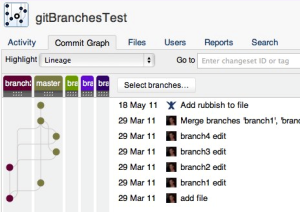Downloads (PDF, HTML & XML formats)
[FishEye Knowledge Base]
FishEye 2.6 introduced the repository commit graph. The commit graph allows you to visualise changesets in their branches by showing them in configurable branch "swimlanes". One of the ways in which you can configure the commit graph is by reordering the swimlanes. Reordering swimlanes is useful for non-Git repositories, if you want to show branches in a certain order. However, ordering swimlanes is vital for Git repositories, as it is the only way of determining which branch a commit is displayed in, when a commit belongs to multiple branches.
Before considering how Git repositories are visualised in the commit graph, it is important to understand how FishEye relates Git changesets to branches.
In FishEye 2.6 and later, FishEye considers the ancestry of a Git changeset when determining which branch it is a part of. Branches can effectively be considered as pointers to changesets. Hence, merging and branching can change the branches that a changeset is considered part of.
For example, if a branch 'fisheye-2.6' is merged back to the 'master' branch, then all changesets that were seen as part of the 'fisheye-2.6' branch only will also be considered to be part of the 'master' (e.g. the changeset will be seen as part of 'master' and 'fisheye-2.6' in the activity stream).
The previous section describes how a changeset can be associated with multiple branches, due to its ancestry. Instead of showing the changeset in every branch swimlane on the commit graph, FishEye represents these changesets as described below.
When you view the commit graph for a Git repository, FishEye works from the leftmost swimlane to the right doing the following:
For example, if the 'master' swimlane is to the left of another swimlane, e.g. 'fisheye-2.6' branch, there will be no changesets shown in the 'fisheye-2.6' swimlane, as all the commits will be picked up in the 'master' swimlane. However, if you move the 'fisheye-2.6' swimlane to the left of the 'master' swimlane, it will pick up all of the FishEye 2.6 commits.
This allows you to visually isolate changesets in the desired branches by reordering the swimlanes. For example, if you want to see the lineage of a branch, 'fisheye-2.6', but not 'fisheye-2.5' after both branches have previously been merged to 'master', you could arrange your swimlanes to 'fisheye-2.6', 'master', 'fisheye-2.5' from left to right. You will be able to see the 'fisheye-2.6' changesets and where the merge back to 'master' was made. The 'fisheye-2.5' changesets will just be seen as part of the 'master' branch.
Screenshots below: Example of how ordering swimlanes affects the branches that changesets are displayed on (click to view full-size images)

|

|

|
|
1
|
2
|
3
|